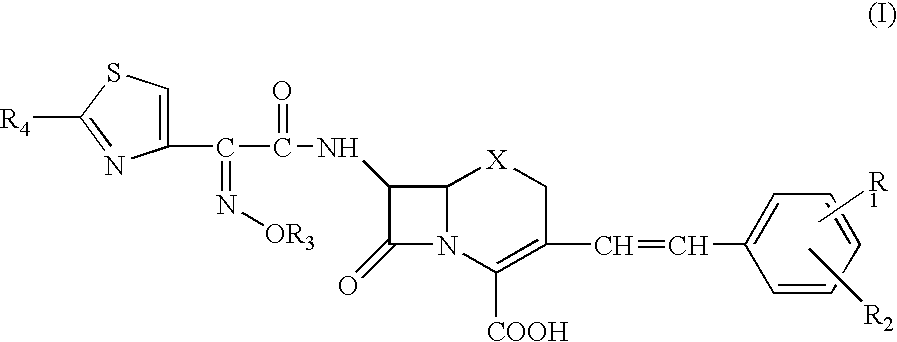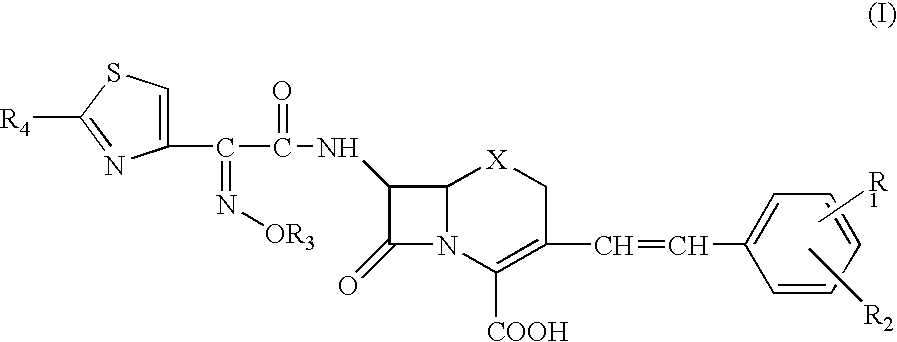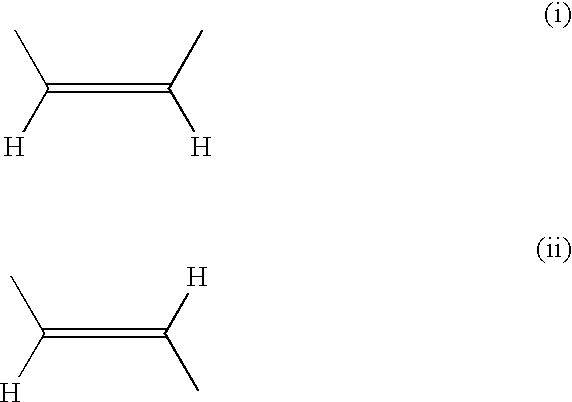Cephem compounds and ESBL-detecting reagents containing the same
a technology of detection reagents and compounds, applied in the field of detection reagents containing the same, can solve the problems of failure to rapid determination, no hope of selective application of esbl-producing bacteria, spreading of esbl-producing bacteria, etc., and achieve the effect of rapid detection of esbls
- Summary
- Abstract
- Description
- Claims
- Application Information
AI Technical Summary
Benefits of technology
Problems solved by technology
Method used
Image
Examples
example 1
Preparation of 7-[2-(2-aminothiazol-4-yl)-2-(1-carboxy-1-methylethoxyimino)acetamido]-3-(2,4-dinitrostyryl)-3-cephem-4-carboxylic acid (compound 1)
[0053](1) 7-[2-(1-Methyl-1-tert-butoxycarbonylethoxyimino)-2-(2-tritylaminothiazol-4-yl)acetamido]-3-chloromethyl-3-cephem-4-carboxylic acid benzhydryl ester (940 mg, 0.97 mmol) dissolved in acetone (10 ml) and added with sodium iodide (145.4 mg, 0.97 mmol) and triphenylphosphine (254.4 mg, 0.97 mmol) was stirred at room temperature for 1 hour. The reaction mixture was condensed under reduced pressure to an extent that acetone was reduced to half. Then, the reaction mixture was added with dichloromethane (10 ml), water (10 ml), 2,4-dinitrobenzaldehyde (760.9 mg, 3.88 mmol) and sodium hydrogen carbonate (244.4 mg, 2.91 mmol) and stirred at room temperature overnight.
[0054]Dichloromethane layer was removed and water layer was extracted with dichloromethane (20 ml) and combined with the last dichloromethane layer and dried over magnesium sul...
example 2
Preparation of 7-[2-(2-aminothiazol-4-yl)-2-(1-carboxy-1-methylethoxyimino)acetamido]-3-(4-nitrostyryl)-3-cephem-4-carboxylic acid (compound 2)
[0060](1) 7-[2-(1-methyl-1-tert-butoxycarbonylethoxyimino)-2-(2-tritylaminothiazol-4-yl)acetamido]-3-chloromethyl-3-cephem-4-carboxylic acid benzhydryl ester (775 mg, 0.8 mmol), sodium iodide (120 mg, 0.8 mmol), triphenylphosphine (210 mg, 0.8 mmol), 4-nitrobenzaldehyde (483 mg, 3.2 mmol) and sodium hydrogen carbonate (200 mg, 2.4 mmol) were used to conduct the procedure similar to that shown in (1) of Example 1 to obtain 568 mg (yield: 66%) of 7-[2-(1-methyl-1-tert-butoxycarbonylethoxyimino)-2-(2-tritylaminothiazol-4-yl)acetamido]-3-(4-nitrostyryl)-3-cephem-4-carboxylic acid benzhydryl ester as yellow powder.
[0061]The NMR spectrum indicated that this specimen was a mixture of Z- and E-isomers (ca 3:1).
[0062]1H-NMR (CDCl3) δ:
(Z-isomer)
[0063]1.43 (9H, s), 1.61 (3H, s), 1.63 (3H, s), 3.11 (1H, d, J=18.3 Hz), 3.32 (1H, d, J=18.3 Hz), 5.08 (1H, d...
example 3
Preparation of 7-[2-(2-aminothiazol-4-yl)-2-(1-carboxy-1-methylethoxyimino)acetamido]-3-(4-cyanostyryl)-3-cephem-4-carboxylic acid (compound 3)
[0070](1) 7-[2-(1-methyl-1-tert-butoxycarbonylethoxyimino)-2-(2-tritylaminothiazol-4-yl)acetamido]-3-chloromethyl-3-cephem-4-carboxylic acid benzhydryl ester (775 mg, 0.8 mmol), sodium iodide (120 mg, 0.8 mmol), triphenylphosphine (210 mg, 0.8 mmol), 4-cyanobenzaldehyde (428 mg, 3.2 mmol) and sodium hydrogen carbonate (200 mg, 2.4 mmol) were used to conduct the procedure similar to that shown in (1) of Example 1 to obtain 464 mg (yield: 55%) of 7-[2-(1-methyl-1-tert-butoxycarbonylethoxyimino)-2-(2-tritylaminothiazol-4-yl)acetamido]-3-(4-cyanostyryl)-3-cephem-4-carboxylic acid benzhydryl ester as cream color powder.
[0071]The NMR spectrum indicated that this specimen was a mixture of Z- and E-isomers (ca 1:1).
[0072]1H-NMR (CDCl3) δ:
(Z-isomer)
[0073]1.43 (9H, s), 1.60 (6H, s), 3.10 (1H, d, J=18.1 Hz), 3.30 (1H, d, J=18.1 Hz), 5.08 (1H, d, J=5.0 H...
PUM
| Property | Measurement | Unit |
|---|---|---|
| temperature | aaaaa | aaaaa |
| diameter | aaaaa | aaaaa |
| color change | aaaaa | aaaaa |
Abstract
Description
Claims
Application Information
 Login to View More
Login to View More - R&D
- Intellectual Property
- Life Sciences
- Materials
- Tech Scout
- Unparalleled Data Quality
- Higher Quality Content
- 60% Fewer Hallucinations
Browse by: Latest US Patents, China's latest patents, Technical Efficacy Thesaurus, Application Domain, Technology Topic, Popular Technical Reports.
© 2025 PatSnap. All rights reserved.Legal|Privacy policy|Modern Slavery Act Transparency Statement|Sitemap|About US| Contact US: help@patsnap.com



